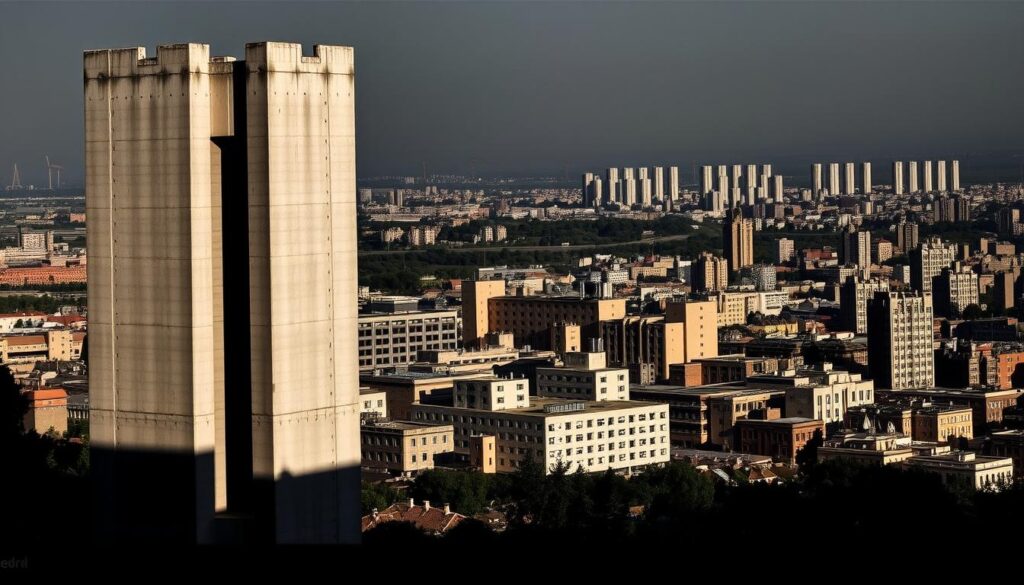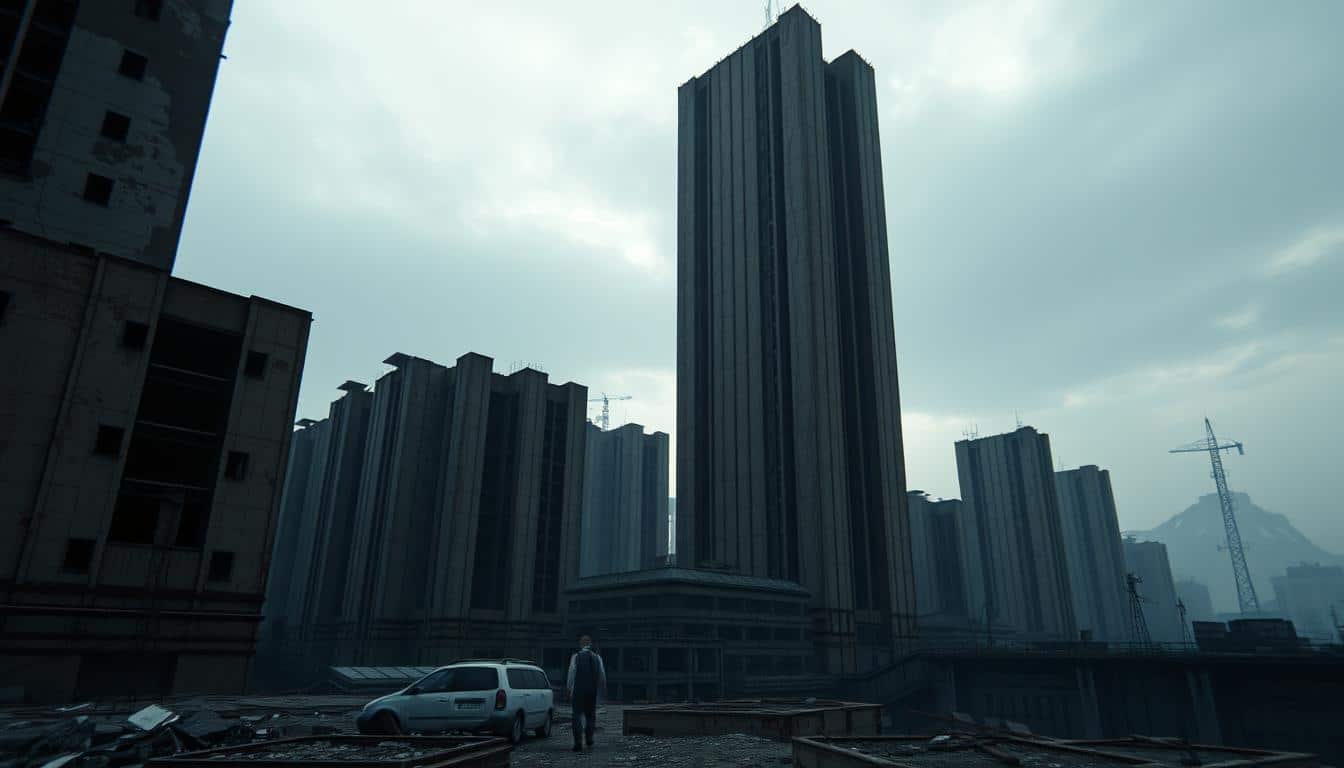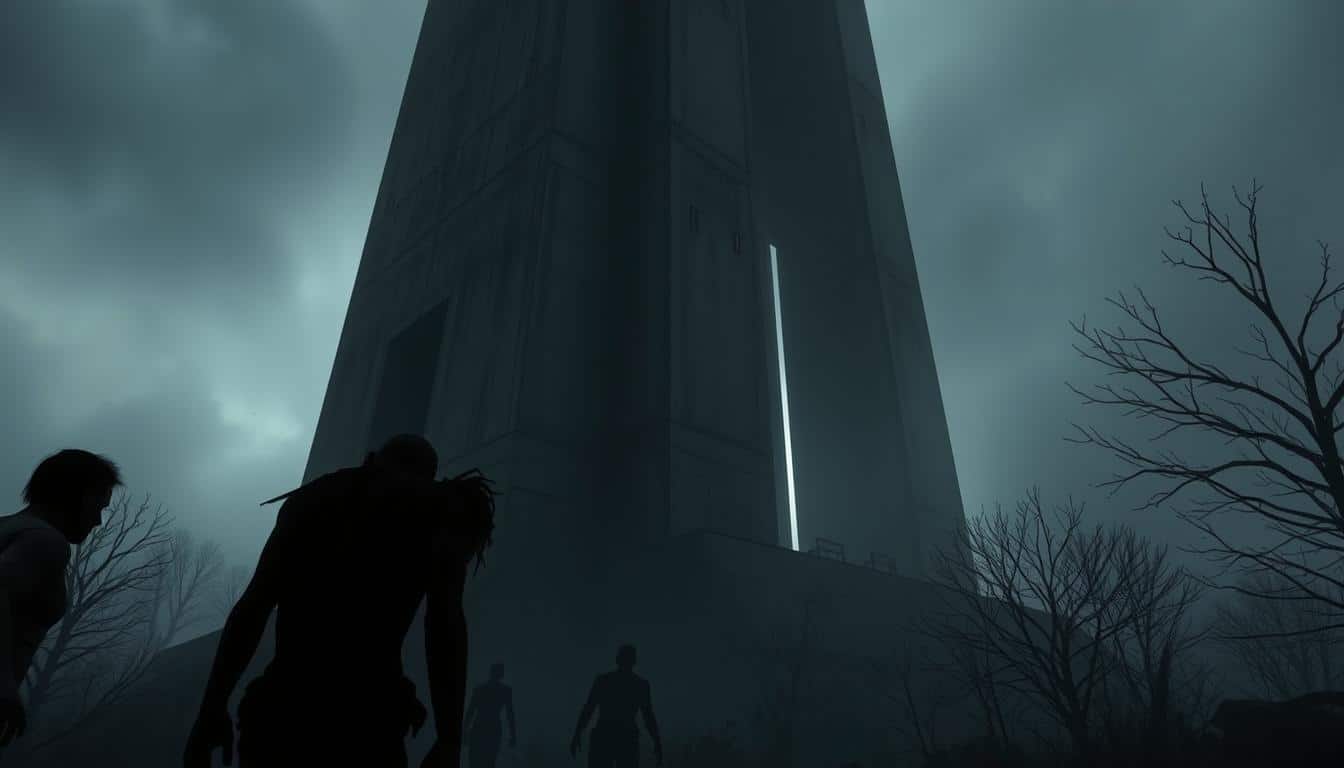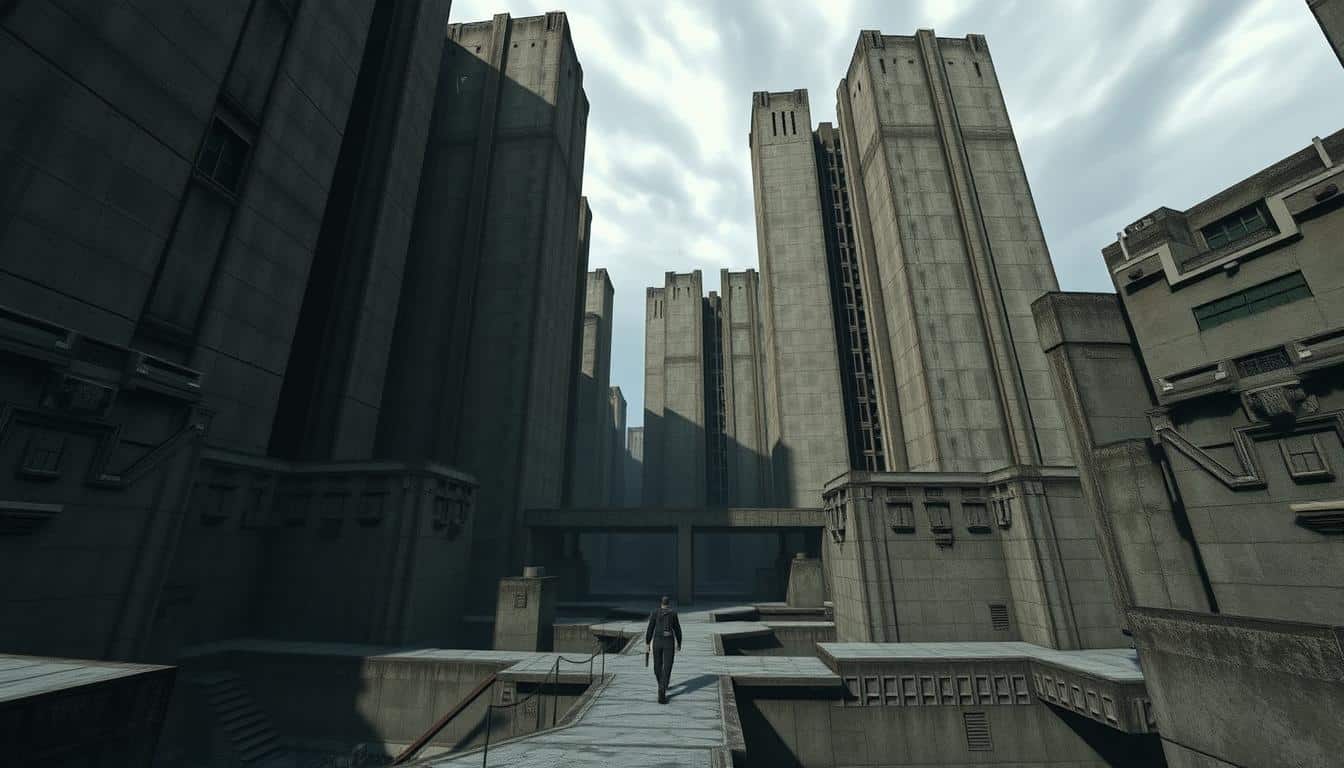The unique look of Soviet Brutalism has really left its mark on today’s game design. Its raw concrete forms and simple styles show up in many video games. Looking into how this architecture is used helps us see how it adds to stories and gameplay.
This deep dive shows why the details of Soviet Brutalism are important in games. It makes playing them more engaging and meaningful.
The Origins of Brutalism
Brutalism started in the early twentieth century, closely linked to Modernism. It came about during fast urban and economic growth, focusing on budget-friendly, useful buildings in busy areas. Soviet Constructivism had a big impact on Brutalism. It wanted to build a society based on socialist ideals.
Historical Context and Development
Brutalism grew after World War II, a time of political and economic challenges, especially in Europe. The damage from the war made it necessary to rebuild and provide housing quickly. Architects aimed for functional yet forward-looking designs.
Notable architects like Le Corbusier pushed for using raw concrete, breaking away from older styles. Brutalism was all about being clear, useful, and hoping to drive social improvement through how cities are built.
Key Architectural Influences
Constructivism influenced Brutalism a lot, pushing for buildings that showed and supported Communist ideals. Le Corbusier’s ideas on modularity and focusing on how buildings serve the community became key to Brutalism. This mix led to structures that looked strong and lasting, mirroring a society aiming for betterment.
The style mixes art with architecture, creating a new way that still has an impact today.

Soviet Brutalism Representation in Game Development
Soviet Brutalism has deeply influenced game design, especially in creating the look and feel of games. Its raw, towering beauty brings games to life, making them more real and engaging. This approach has changed video games, letting players dive into worlds that pull at their emotions.
Impact on Visual Design and Aesthetics
The stark features of Soviet Brutalism have changed how games look. Features like thick textures, simple colors, and bold shapes make a unique style. These traits pull players into the game world. Game makers use these designs to make visuals that improve gameplay and story.
Integration in Game Environments
Game makers have cleverly woven brutalist architecture into their worlds, using it to tell stories. This blending does two things. It creates a strong sense of location and brings up topics relevant to society. Adding these designs into games gives characters more backstory and makes player interactions more meaningful.
The Aesthetic Characteristics of Brutalism
Brutalism’s look is all about practical design, favoring function over decoration. This approach means that a building’s look should show what it’s used for. In video games, this idea creates spaces that are easy to use and deeply draw players in.
Utilitarian Design Elements
Brutalism peels away any extra flair to spotlight simplicity and practicality. You’ll often see:
- Rugged textures showcasing natural materials
- Exposed structures that put emphasis on usefulness
- Spacious layouts that adapt well to different game actions
This bare-bones approach lends a feeling of sturdiness and realness, making game worlds more engaging for players.
Color Palette and Material Use
Soviet Brutalism’s colors are mostly subdued, with lots of grays and earthy hues. This fits perfectly with games that explore grim futures and survival. Key traits are:
- Simple color schemes creating a grim mood
- Textured surfaces that make the game feel more hands-on
- Natural materials bringing the game’s world to life
These features combine to make a unified setting that boosts storytelling and keeps players involved in the game.
Brutalism in Game Architecture
Exploring brutalism in game architecture uncovers a world of creativity. Brutalist style creates iconic environments that enrich stories and engage players. Many games use these designs to change both look and play.
Case Studies of Iconic Game Environments
Some games are known for their brutalist design, improving player experiences with careful architecture. These case studies show how:
- Nova Drift – Its minimalistic style focuses on bold shapes and contrasts, pulling players into a special story of space.
- Control – The Federal Bureau of Control mixes brutalism with surrealism, creating a complex world for players to explore.
- DOOM Eternal – It embodies brutalism with its massive structures. This adds to the thrill of combat and exploration.
Player Experience and Interaction
Players react differently to brutalist game environments. The style’s raw look leads to deeper interest in games and stories. It challenges players, making them think about the game in new ways. This approach doesn’t just make a visual impact; it changes how we play.
Cultural Impact of Soviet Brutalism in Games
Soviet Brutalism in games is more than looks. It explores heavy themes like oppression, resilience, and identity. Its architecture adds depth to game stories, making players think and feel more deeply.
Reflecting Societal Themes and Narratives
This influence brings unique stories to life in games. Players move through spaces that show struggle and victory. Brutalist designs stand for tough times but also survival and endurance. They make players feel more, making games better.
Games with Soviet Brutalism dig into big topics like:
- Oppression faced by individuals or groups
- The resilience required to overcome such adversities
- Questions of identity in a rapidly changing world
Playing these games is a trip that’s fun and thought-provoking. They mix Brutalism and deep stories for a stronger game world connection.
From Architecture to Digital Worlds
Switching from architecture to game design needs a strong understanding of turning physical spaces into digital ones. Designers tackle many challenges when bringing the bold features of brutalist architecture to life in games. They work on scale, structure, and keeping the unique look of these buildings.
The aim is to blend the original architecture smoothly with fun game experiences. This requires careful work and creativity.
Translating Architectural Elements into Game Design
Game developers put a lot of thought into transferring architecture into games. They focus on these main points:
- Keeping buildings realistic.
- Using real textures and materials digitally.
- Making spaces easy for players to move around in.
This attention to detail creates worlds that players believe in and want to explore. It’s not just about making spaces look good. The spaces must also work well in the game.
Challenges and Innovations in Representation
As designers strive for realism, they face technical hurdles and the need for creative answers. They’ve come up with new methods such as:
- Better rendering tech for showing off architecture.
- Procedural generation for ever-changing environments.
- New user interfaces that help players dive deeper into the game.
These steps help overcome the stiffness of brutalist architecture, making game mechanics more dynamic. By managing these challenges, creators can turn architectural beauty into engaging game settings. Players then get to enjoy games that respect the original architectural wonders.
The Role of Brutalism in Storytelling
Soviet Brutalism is key in game storytelling, making the player’s experience better. The raw look and feel create a strong sense of place. This adds depth to the story. Players get pulled into worlds that make them feel things. These feelings are related to the buildings and the themes in the game.
Creating Atmosphere through Design
Brutalist architecture’s unique features create a special atmosphere. This atmosphere affects how players feel. The use of concrete, big spaces, and simple shapes makes an interesting world. This world is perfect for exploring and thinking. This design is important for building game worlds. It helps tell stories that pull players in even more. Using this design makes stories in games more engaging. Every part of the design adds to the story.
Emphasizing Themes of Resistance and Authenticity
Brutalist design shows ideas of resistance and being real in the stories it tells. The simplicity of these places shows the fight against unfair systems. This makes players think more about big social issues and what it means to be human. Characters and stories happen against these real settings. This makes players connect more deeply. By using these themes, games send strong messages. They do more than entertain. They make players think about life in our changing world.
Contemporary Examples in Gaming
Games today are bringing back a style called brutalist aesthetics. Game designers use these ideas to make unique experiences. They mix these styles into the game play and stories, creating a special feel that matches the tough and practical look of brutalism.
Notable Games Featuring Brutalist Design
Some games really show off brutalist design in their worlds and stories. Here are a few:
- Control – This game stands out with its bare environments and big buildings. It takes players into a spooky world that mixes brutalist and modern ideas.
- Mirrored – A simple yet challenging puzzle game. It uses straight lines and shapes to build a game based on brutalist ideas, making players think hard in a visually interesting space.
- Prodeus – With an old-school feel, this shooter uses brutalist designs to make a lively, but rough atmosphere. It nods to the old first-person shooters.
Critics’ Perspectives on Aesthetic Choices
Critics have a lot to say about these games and their bold brutalist looks. They praise how these visuals pull you deeper into the game. While some think this makes games more engaging, others worry it might distract from the gameplay. The critics have a deep look into how brutalist style changes the way we play.
Conclusion
This look into Soviet Brutalism in game development shows its deep historical and aesthetic impact. Through game design, it shares rich cultural stories and themes. These make game worlds feel real and vivid.
The raw, simple shapes and stark beauty of Soviet Brutalism reflect life’s realities and add to game storytelling. This makes games more engaging and meaningful.
We’ll see more of Brutalist design in future games, as technology and creativity grow. Developers use its elements to make new, exciting game experiences. Brutalism will keep influencing game worlds, proving it’s a lasting trend in game design.



